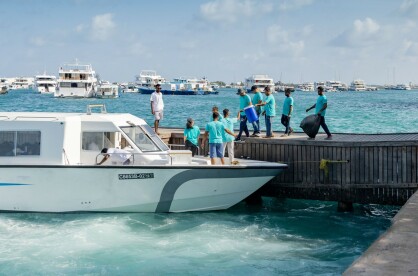The Maldives has been known as a haven filled with locations that make you feel like you’re on an undiscovered, untouched land. For this reason, thousands travel from across the globe each year to the Maldives to discover its pristine waters, colourful marine life and that vibrant un-discovered island feeling that is hard to get anywhere else in the world. With this, the Maldives has been giving extra importance to maintaining its eco-system through more sustainable initiatives as well as protecting the abundance of diverse and colourful marine life it holds in its underwater world that is awaiting to be discovered.
While this might be true, the Maldives is still a developing nation that seeks several development projects each year. With this, there is always a threat to the environment, especially when ongoing or new projects require any form of dredging to be done. In order to compensate for the environmental damage that these projects cause, the Government of the Maldives introduced the Biodiversity Offset Plan - which specifically targets compensating for the damages that will occur during the Gulhi Falhu reclamation project. Under the Biodiversity Offset Plan, the Ministry of Climate Change, Environment and Energy has now announced the protection of two different lagoons which have become extremely popular among tourists as well as divers. These lagoons are the Bodu Hithi Thila which is located in the Western part of Male’ Atoll and the Okkobe Thila which is located in the Eastern part of Male’ Atoll.
While these two locations have become immensely popular due to the colourful corals and the variety of beautiful fishes that can be spotted, under the new protection plan divers will have to take various factors into consideration which includes the prohibition of:
- Exploration and mining for oil, gas, or minerals of any kind
- Littering
- Land reclamation
- Removal of stones, sand, coral, and limestone
- Anchoring
- Development and infrastructure
- Discharge of pollutants or outfall
- Aquaculture or mariculture work
- Removing, killing, abusing, and capture of species in the area except for sustainable fishing
- Removal of eggs or damage to the nest of any species
- Introducing species not native to the area
- Feeding or adding food for any species, including fish and birds
- Illuminating the area at night
- Making noise that disrupts the habits of the animals
- Catching any species of small fish other than the fish used as bait in Maldives (including all types of juvenile fish in aquariums and tanks and reef fish)
- Luring fish to the surface using light at night (fishing under the Fisheries Act and fishing using light from a vessel with a valid license issued for tuna fishing using handlines are allowed)
Although these are the new rules for the protected areas, many of these rules are advised to be noted during any type of diving trip in the Maldives.







